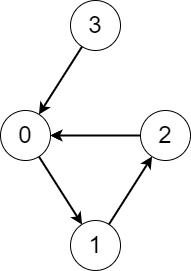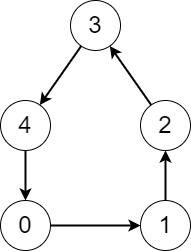LeetCode in Kotlin
2876. Count Visited Nodes in a Directed Graph
Hard
There is a directed graph consisting of n nodes numbered from 0 to n - 1 and n directed edges.
You are given a 0-indexed array edges where edges[i] indicates that there is an edge from node i to node edges[i].
Consider the following process on the graph:
- You start from a node
xand keep visiting other nodes through edges until you reach a node that you have already visited before on this same process.
Return an array answer where answer[i] is the number of different nodes that you will visit if you perform the process starting from node i.
Example 1:

Input: edges = [1,2,0,0]
Output: [3,3,3,4]
Explanation: We perform the process starting from each node in the following way:
- Starting from node 0, we visit the nodes 0 -> 1 -> 2 -> 0. The number of different nodes we visit is 3.
- Starting from node 1, we visit the nodes 1 -> 2 -> 0 -> 1. The number of different nodes we visit is 3.
- Starting from node 2, we visit the nodes 2 -> 0 -> 1 -> 2. The number of different nodes we visit is 3.
- Starting from node 3, we visit the nodes 3 -> 0 -> 1 -> 2 -> 0. The number of different nodes we visit is 4.
Example 2:

Input: edges = [1,2,3,4,0]
Output: [5,5,5,5,5]
Explanation: Starting from any node we can visit every node in the graph in the process.
Constraints:
n == edges.length2 <= n <= 1050 <= edges[i] <= n - 1edges[i] != i
Solution
class Solution {
fun countVisitedNodes(edges: List<Int>): IntArray {
val n = edges.size
val visited = BooleanArray(n)
val ans = IntArray(n)
val level = IntArray(n)
for (i in 0 until n) {
if (!visited[i]) {
visit(edges, 0, i, ans, visited, level)
}
}
return ans
}
private fun visit(
edges: List<Int>,
count: Int,
curr: Int,
ans: IntArray,
visited: BooleanArray,
level: IntArray,
): IntArray {
if (ans[curr] != 0) {
return intArrayOf(-1, ans[curr])
}
if (visited[curr]) {
return intArrayOf(level[curr], count - level[curr])
}
level[curr] = count
visited[curr] = true
val ret = visit(edges, count + 1, edges[curr], ans, visited, level)
if (ret[0] == -1 || count < ret[0]) {
ret[1]++
}
ans[curr] = ret[1]
return ret
}
}

